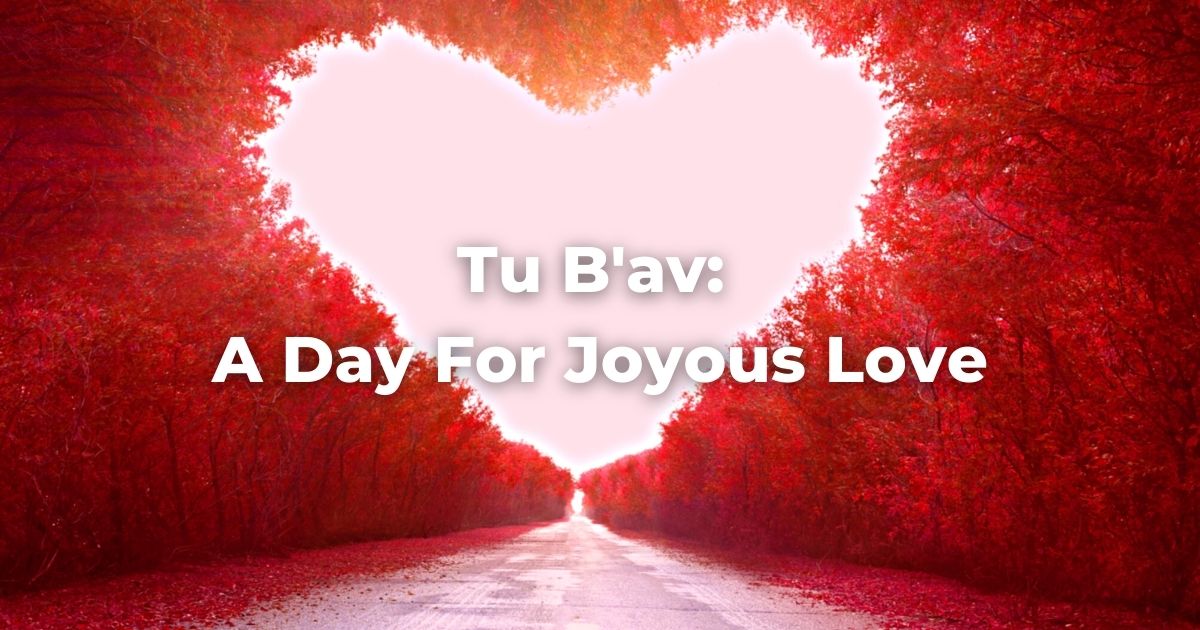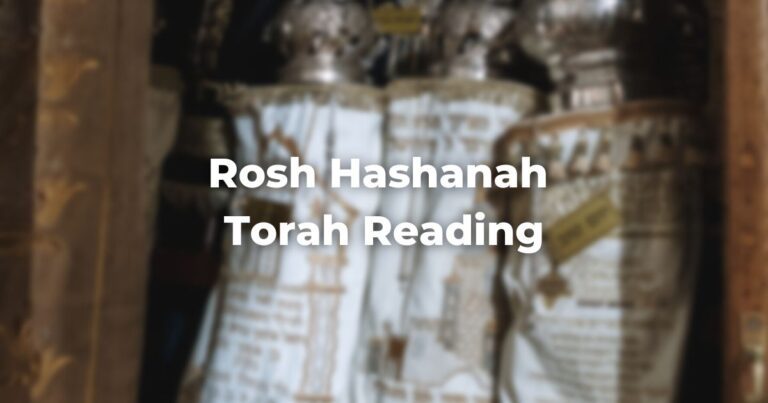According to Rabbi Alan Lucas, “Tu Be’av, the fifteenth of the month of Av, is a minor holiday. According to the TalmudReferring to one of two collections, the Jerusalem and Babylonian Talmuds, edited in the 6th century, that contains hundreds of years of commentary, discussion, and exploration of the ideas in the Mishnah. One could describe it as Mishnah + Gemara = Talmud it was celebrated as a day of rejoicing in the times of the Temple. It was almost like a Jewish Sadie Hawkins day where in ancient times the unmarried Jewish girls of Jerusalem would dress in white and go out dancing in the streets and vineyards.
According to the Talmud, there were no happier times in the Jewish year than the successful completion of Yom Kippur and Tu Be’av [Taanit 30b]. In modern Israel it is called hag ha-ahavah, the holiday of love.”
What Happened on Tu B’av?
Just as Tisha B’av commemorates multiple tragic events in Jewish history, Tu B’av commemorates multiple occasions in Jewish history. However, the events of the fifteenth of Av celebrate times of rejoining and rejoicing, before and after the Israelites entered into the land of Israel.
Before the Land of Israel
Allowance for Inter-Tribal Marriage
Unsurprisingly, inheritance and property ownership in the time of the Bible passed through men—from father to son, remembering the father’s name through this practice. In Numbers 27, Zelophehad died without sons, only daughters. Mahlah, Noah, Hoglah, Milcah, and Tirzah approached the Israelite leadership, asking his property to be divided between them, to remember their father.
God granted permission for a fundamental property law to change: first, the property would go to sons; with no sons, the property would be passed to daughters; with no daughters, the property would be passed to brothers of the deceased; only then, with no brothers, would the property be passed to the next of kin.
However, the rest of Zelophehad’s tribe approached Israelite leadership in Numbers 36, protesting this—if these daughters inherited this property and then married outside of the tribe, the daughters’ property would pass to the tribe of their husband, taking property from their father’s tribe.
In order to prevent this, God addended the law: daughters with inheritance could only marry inside their own tribe. This ruling partially prevented inter-tribal marriage.
The rabbis interpreted that this ruling was only for those in that generation, the people that would enter the land and divide it by tribe. Tu B’av celebrated the ending of this rule and the allowance for inter-tribal marriage. The rabbis declared this day a permanent day of rejoicing, because of this.
See more: Parashat Pinchas
The Tribe of Benjamin’s Allowance into the Community
Judges 19 remembers a gruesome and violent story involving members of the tribe of Benjamin, rape, abuse, and murder. Judges 20-21 remembers the reaction of the rest of Israel. Because of the brutality of the tribe of Benjamin, the Israelites declared, “None of us must ever give his daughter in marriage to a Benjamanite (Judges 21:1).”
Similarly to the rabbis’ interpretation to the laws of the daughters of Zelophehad, the phrase “none of us” refers only to those in the generation present in these moments. A new generation allows for the ending of this rule, on the fifteenth of Av.
Death in the Wilderness Ceases
In Numbers 13-14 and Deuteronomy 1, God sent twelve spies to scope out the nature of the land of Israel. While two spies—Joshua and Caleb—returned with an optimistic report of the land and its inhabitants, the other ten spies arrived back with pessimism. They declared that the Israelites would not be able to defeat the current inhabitants of the land. Marking their faithlessness in God, the rest of the Israelites sided with the ten.
God punished them and declared that this generation—the generation that had been alive for the Exodus from Egypt but had spent forty years complaining, showing their faithlessness in God—would not see the land promised to them. Only the new generation, born in the desert, was allowed to enter the land of Israel.
Tu B’av commemorates the transition to this new generation: Rav Nachman calls it, “The day on which the deaths in the desert ceased.” According to Rabbi Dr. Joshua Kulp in the English explanation of MishnahA collection of rabbinic teachings edited in Israel around 225 CE. Organized in six sedaraim by subject matter and dealing with both ritual and civil law. Both the Jerusalem and Babylonian Talmud are expansive discussions of the Mishnah. Ta’anit 4:8, “Anyone who made it through this day in the fortieth year in the desert knew that he was going to make it to the land of Canaan.”
This generational change also explains the generational law changes seen above.
See more: Parashat Sh’lach
Life in the Land of Israel
Jeroboam placed guards and barriers on the roads to Jerusalem to prevent Jewish pilgrimage on the festivals. The fifteenth of Av marks the day when Hoshea ended this and declared that Jews could go wherever they wanted.
In Beitar (Gittin 57a), it was the custom to plant a cedar when a boy was born and a cypress when a girl was born. When a couple married, their trees were cut down for their chuppah, wedding canopy, for them.
Once, the emperor’s daughter’s carriage broke and her attendants used one of these trees for her. But due to the importance of this custom, the residents of Beitar became angered. The attendants reported to the emperor that the Jews were rebelling and he declared war.
The fifteenth of Av marked the day of burial for those killed at Beitar. A blessing was made, thanking God that the bodies had not decomposed before they could be properly buried.
Tu B’av also marked the end of chopping down trees to be burned on the altar. Improperly dry wood would be unfit for use in the Temple and on that day, “the strength of the sun [grew] weaker,” and any wood chopped from then on would not be dry and therefore fit for use in the Temple. The ending of chopping down trees, called “the Day of the Breaking of the Scythe,” is also used as a celebration for the trees.
The extended explanation on these reasons can be found in Taanit 30b-31a.
How Was Tu B’av Originally Celebrated?
It is said that on Tu B’av, the daughters of Zion adorned themselves in white, pure garments, and danced in the vineyards, celebrating the joys and gladness of the day. Single men were encouraged to find their brides during this celebration, which some compare to a Sadie Hawkins dance, as demonstrated by Rabbi Lucas above.
All of the women borrowed white dresses from each other, so as to prevent embarrassment to any one who could not purchase a white dress. The practice for campers to borrow Shabbat clothes from their bunkmates has these beautiful Talmudic origins, a midrashThis word is used in two ways, as both a concept and a literature. As a concept, midrash is the expansive interpretation of biblical texts. The term is used to describe the practice of rabbinic interpretation. As a text, it refers to specific collections of interpretations, particularly from the third to ninth centuries in the Land of Israel and Babylonia. Plural: Midrashim
in and of itself.
The men, watching these women dance, were encouraged to find brides based on their family lineage, rather than their beauty.
While the day was about celebrating and rejoicing for the reasons above, it also became a day for young women to approach men for marriage, rather than the other way around.
More is described in Mishnah Taanit 4:8 and BT Taanit 30b-31a.
How Is Tu B’av Celebrated Today?
This summer holiday is widely celebrated in Israel and has become similar to Valentine’s day in other parts of the world. In Israel, the day is called “hag ha-ahavah,” the holiday of love. Even in Talmudic times, the holiday of Tu B’av was one of the happiest days of the year, rivaling only the happiness of Yom Kippur (Mishnah Taanit 4:8).
In Israel, there will be concerts and romantic hike routes taken. Many couples celebrate Tu B’av by getting engaged or married.
Even outside of the land of Israel, you can celebrate the joy of Tu B’av by sharing love with the people around you, in whatever ways you can. Most importantly, celebrate joyous love.
Tu B’av is the final holiday of the Jewish calendar year and marks the transition to the High Holidays.
Author
-

Reena Bromberg Gaber is a student in the Joint Program with Columbia University and the Jewish Theological Seminary. At school, she is involved with Columbia/Barnard Hillel, Gamma Phi Beta, the Columbia Daily Spectator, and Artists Reaching Out. Growing up, Reena was involved with the Conservative movement, including many summers as a camper and staff member at Camp Ramah in the Poconos and in local, regional, and international leadership positions in USY. As Reena moves through college and into adulthood, she is excited to find a space for herself and her peers in the Conservative movement.
View all posts






